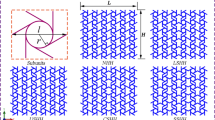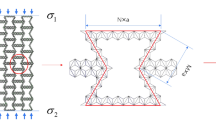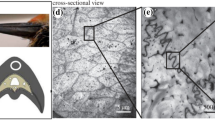Abstract
As an alternative to the conventional concave hexagonal honeycomb structure (CHHS), a negative Poisson’s ratio honeycomb structure with power function curve (NHPC) was devised. The relationship between the power function exponent (PFE) and normalized power function coefficient (NPFC) of honeycomb structure and its equivalent Poisson’s ratio (EPR) was explored to identify the range of variables required for the negative Poisson’s ratio effect. To investigate the in-plane mechanical properties and energy absorption characteristics of NHPC, the deformation mode, dynamic response, and energy absorption characteristics under various impact velocities were studied by constructing an in-plane impact simulation model. The results showed that NHPC obviously exhibited a negative Poisson’s ratio effect on medium and low impact velocities, and the deformation was primarily uniform. As the NPFC increased, the honeycomb structure was less prone to stress concentration, while the peak crushing force (PCF) and the specific energy absorption (SEA) declined and the plateau stress increased. A multi-objective optimization experiment was operated with low PCF and high SEA as the targets within the range of design variables in order to generate the optimal NHPC. According to the experimental findings, the improved NHPC showed a 25.48 % reduction in PCF and a 19.29 % increase in SEA. This paper provides theoretical recommendations for improving the energy absorption and structural optimization of the honeycomb structure.
Similar content being viewed by others
Abbreviations
- CHHS:
-
concave hexagonal honeycomb structure
- NHPC:
-
negative Poisson’s ratio honeycomb structure with power function curve
- PFE:
-
power function exponent
- NPFC:
-
normalized power function coefficient
- EPR:
-
equivalent Poisson’s ratio
- PCF :
-
peak crushing force
- SEA :
-
specific energy absorption
- FE:
-
finite element
- l :
-
distance between the cell’s two straight arms, mm
- h :
-
length of the straight arms on either side of the cell, mm
- A :
-
power function coefficient
- A n :
-
normalized power function coefficient
- α :
-
power function exponent
- ν :
-
impact velocity, m/s
- ε :
-
nominal strain
- μ :
-
Poisson’s ratio of the material
- ε x :
-
transverse strain
- ε y :
-
longitudinal strain
- ΔX :
-
transverse compression of the material, m
- L 1 :
-
transverse length of the material, m
- ΔY :
-
average value of the boundary displacement on both sides of the material, m
- L 2 :
-
longitudinal length of the material, m
- μ e :
-
equivalent Poisson’s ratio of the material
- F:
-
impact force, N
- b :
-
out-plane thickness of the honeycomb structure, m
- δ :
-
compression displacement, m
- σ p :
-
plateau stresses, MPa
- ε cr :
-
yield strain, i.e. the nominal strain value when the nominal stress reaches the initial peak stress, m
- σ(ε):
-
nominal stress
- ε d :
-
locking strain, i.e., the nominal strain corresponding to the honeycomb structure when it enters the densification stage
- Δρ :
-
relative density of the honeycomb material
- ρs :
-
density of the matrix material, kg/m3
- E m :
-
SEA of the honeycomb structure, J/kg
- E v :
-
energy absorbed per unit volume of the honeycomb structure, J/m3
- R 2 :
-
determination coefficient
- RMSE :
-
root mean square error value
- f i :
-
analysis value of the i sample point
- f′i :
-
response face value of the i sample point
- \({\bar f}\) :
-
average analysis value of all sample points
- N :
-
total number of sample points
- p:
-
number of the polynomial
- \(\overline {{f_i}} \) :
-
mean deviation of all solutions to the objective function fi in the Pareto solution set Ψ
- ρ(f i):
-
standard deviation of all solutions to the objective function fi in the Pareto solution set Ψ
- Nf :
-
number of optimization objectives
- f i(i):
-
initial values of the objective function fi
- \(f_i^Z(i)\) :
-
regularized values of the objective function fi
- \(g_i^Z(i)\) :
-
weighted results of \(f_i^Z(i)\)
- \(g_i^{Z*}\) :
-
corresponding ideal points
References
Abdullah, N. A. Z., Sani, M. S. M., Salwani, M. S. and Husain, N. A. (2020). A review on crashworthiness studies of crash box structure. Thin-Walled Structures, 153, 106795.
Abyani, M. and Bahaari, M. R. (2020). A comparative reliability study of corroded pipelines based on Monte Carlo Simulation and Latin Hypercube Sampling methods. Int. J. Pressure Vessels and Piping, 181, 104079.
Agarwal, A. and Mthembu, L. (2022). Structural analysis and weight optimization of automotive chassis by Latin hypercube sampling using metal matrix composites. Materials Today: Proc., 60, 2132–2140.
Alhajahmad, A. and Mittelstedt, C. (2022). A novel grid-stiffening concept for locally reinforcing window openings of composite fuselage panels using streamline stiffeners. Thin-Walled Structures, 179, 109731.
Alkhader, M., Abuzaid, W., Elyoussef, M. and Al-Adaileh, S. (2020). Localized strain fields in honeycomb materials with convex and concaved cells. European J. Mechanics-A/Solids, 80, 103890.
Arslan, K. and Gunes, R. (2018). Experimental damage evaluation of honeycomb sandwich structures with Al/B4C FGM face plates under high velocity impact loads. Composite Structures, 202, 304–312.
Bogoclu, C., Roos, D. and Nestorović, (2021). Local Latin hypercube refinement for multi-objective design uncertainty optimization. Applied Soft Computing, 112, 107807.
Chen, D. H. and Nisitani, H. (1997). Effect of Poisson’s ratio on elastic-plastic stress under plane deformation. Engineering Analysis with Boundary Elements 20, 1, 17–24.
Chu, Y., Sun, L. and Li, L. (2019). Lightweight scheme selection for automotive safety structures using a quantifiable multi-objective approach. J. Cleaner Production, 241, 118316.
Galehdari, S. A., Kadkhodayan, M. and Hadidi-Moud, S. (2015). Low velocity impact and quasi-static in-plane loading on a graded honeycomb structure; experimental, analytical and numerical study. Aerospace Science and Technology, 47, 425–433.
Gibson, L. J., Ashby, M. F., Schajer, G. S. and Robertson, C. I. (1982). The mechanics of two-dimensional cellular materials. Proc. Royal Society of London. A. Mathematical and Physical Sciences 382, 1782, 25–42.
Gupta, M. K. and Singhal, V. (2022). Review on materials for making lightweight vehicles. Materials Today: Proc., 56, 868–872.
Hou, W., Shen, Y., Jiang, K. and Wang, C. (2022). Study on mechanical properties of carbon fiber honeycomb curved sandwich structure and its application in engine hood. Composite Structures, 286, 115302.
Jiang, F., Yang, S., Qi, C. and Liu, H. T. (2022). Two plateau characteristics of re-entrant auxetic honeycomb along concave direction. Thin-Walled Structures, 179, 109665.
Li, L., Yen, G. G., Sahoo, A., Chang, L. and Gu, T. (2021). On the estimation of pareto front and dimensional similarity in many-objective evolutionary algorithm. Information Sciences, 563, 375–400.
Li, X., Lu, F., Lin, Y., Zhang, Y. and Chen, R. (2020). Influence of cell size effect on the vertical cutting of hexagonal thin-walled honeycombs by parallel blades. Thin-Walled Structures, 157, 107137.
Liang, H., Wang, Q., Pu, Y., Zhao, Y. and Ma, F. (2021). In-plane compressive behavior of a novel self-similar hierarchical honeycomb with design-oriented crashworthiness. Int. J. Mechanical Sciences, 209, 106723.
Lin, H. B., Liu, H. T. and An, M. R. (2022). In-plane dynamic impact behaviors of a self-similar concentric star honeycomb with negative Poisson’s ratio. Materials Today Communications, 33, 104474.
Liu, D., Chiu, L. N., Davies, C. and Yan, W. (2020). A post-processing method to remove stress singularity and minimize local stress concentration for topology optimized designs. Advances in Engineering Software, 145, 102815.
Liu, J. Y. and Liu, H. T. (2022). Energy absorption characteristics and stability of novel bionic negative Poisson’s ratio honeycomb under oblique compression. Engineering Structures, 267, 114682.
Liu, Y., Wan, X., Xu, W., Shi, L., Deng, G. and Bai, Z. (2022). An intelligent method for accident reconstruction involving car and e-bike coupling automatic simulation and multi-objective optimizations. Accident Analysis & Prevention, 164, 106476.
Lotfan, S., Ghiasi, R. A., Fallah, M. and Sadeghi, M. H. (2016). ANN-based modeling and reducing dual-fuel engine’s challenging emissions by multi-objective evolutionary algorithm NSGA-II. Applied Energy, 175, 91–99.
Luo, H. C., Ren, X., Zhang, Y., Zhang, X. Y., Zhang, X. G., Luo, C., Cheng, X. and Xie, Y. M. (2022). Mechanical properties of foam-filled hexagonal and re-entrant honeycombs under uniaxial compression. Composite Structures, 280, 114922.
Menna, C., Zinno, A., Asprone, D. and Prota, A. (2013). Numerical assessment of the impact behavior of honeycomb sandwich structures. Composite Structures, 106, 326–339.
Niu, X., Xu, F. and Zou, Z. (2023). Bionic inspired honeycomb structures and multi-objective optimization for variable graded layers. J. Sandwich Structures & Materials 25, 2, 215–231.
Niu, X., Xu, F., Zou, Z., Fang, T., Zhang, S. and Xie, Q. (2022). In-plane dynamic crashing behavior and energy absorption of novel bionic honeycomb structures. Composite Structures, 299, 116064.
Pan, J., Fang, H., Xu, M. C. and Xue, X. Z. (2020). Dynamic performance of a sandwich structure with honeycomb composite core for bridge pier protection from vehicle impact. Thin-Walled Structures, 157, 107010.
Petchrompo, S., Coit, D. W., Brintrup, A., Wannakrairot, A. and Parlikad, A. K. (2022). A review of Pareto pruning methods for multi-objective optimization. Computers & Industrial Engineering, 108022.
Qi, C., Jiang, F., Yang, S., Remennikov, A., Chen, S. and Ding, C. (2022). Dynamic crushing response of novel re-entrant circular auxetic honeycombs: Numerical simulation and theoretical analysis. Aerospace Science and Technology, 124, 107548.
Qi, J., Li, C., Tie, Y., Zheng, Y. and Duan, Y. (2021). Energy absorption characteristics of origami-inspired honeycomb sandwich structures under low-velocity impact loading. Materials & Design, 207, 109837.
Rathod, S., Khaire, N. and Tiwari, G. (2022). A comparative study on the ballistic performance of aramid and aluminum honeycomb sandwich structures. Composite Structures, 299, 116048.
Ruan, D., Lu, G., Wang, B. and Yu, T. X. (2003). In-plane dynamic crushing of honeycombs—a finite element study. Int. J. Impact Engineering 28, 2, 161–182.
Starostin, E. L. and van der Heijden, G. H. M. (2022). Forceless folding of thin annular strips. J. Mechanics and Physics of Solids, 169, 105054.
Sun, G., Chen, D., Zhu, G. and Li, Q. (2022). Lightweight hybrid materials and structures for energy absorption: A state-of-the-art review and outlook. Thin-Walled Structures, 172, 108760.
Usta, F., Türkmen, H. S. and Scarpa, F. (2022). High-velocity impact resistance of doubly curved sandwich panels with re-entrant honeycomb and foam core. Int. J. Impact Engineering, 165, 104230.
Vořechovský, M. and Mašek, J. (2020). Distance-based optimal sampling in a hypercube: Energy potentials for high-dimensional and low-saturation designs. Advances in Engineering Software, 149, 102880.
Wan, Y., Hou, Y., Xiong, Y., Dong, Z., Zhang, Y. and Gong, C. (2022). Interval optimization design of a submersible surface ship form considering the uncertainty of surrogate model. Ocean Engineering, 263, 112262.
Wang, G., Liu, J. and Lu, Z. (2022). Local impact resistance of curved sandwich panels with coaxial and concentric honeycombs. Composite Structures, 299, 116092.
Wang, H., Lu, Z., Yang, Z. and Li, X. (2019). In-plane dynamic crushing behaviors of a novel auxetic honeycomb with two plateau stress regions. Int. J. Mechanical Sciences, 151, 746–759.
Wang, T., Dong, R., Zhang, S. and Qin, D. (2020). Research on lightweight design of automobile collision safety structure based on multiple materials. J. Physics: Conf. Series 1670, 1, 012004. IOP Publishing.
Wei, Y. C., Tian, M. J., Huang, C. Y., Wang, S. W., Li, X., Hu, Q. R. and Yuan, M. Q. (2022). Topological study about failure behavior and energy absorption of honeycomb structures under various strain rates. Defence Technology.
Wesselmecking, S., Kreins, M., Dahmen, M. and Bleck, W. (2022). Material oriented crash-box design-Combining structural and material design to improve specific energy absorption. Materials & Design, 213, 110357.
Xu, F., Yu, K. and Hua, L. (2021). In-plane dynamic response and multi-objective optimization of negative Poisson’s ratio (NPR) honeycomb structures with sinusoidal curve. Composite Structures, 269, 114018.
Xue, X., Zhang, C., Chen, W., Wu, M. and Zhao, J. (2019). Study on the impact resistance of honeycomb sandwich structures under low-velocity/heavy mass. Composite Structures, 226, 111223.
Yang, B., Wang, H., Chen, Y., Fu, K. and Li, Y. (2021). Experimental evaluation and modelling of drilling responses in CFRP/honeycomb composite sandwich panels. Thin-Walled Structures, 169, 108279.
Yin, S., Chen, H., Wu, Y., Li, Y. and Xu, J. (2018). Introducing composite lattice core sandwich structure as an alternative proposal for engine hood. Composite Structures, 201, 131–140.
Zhang, J., Zhu, X., Yang, X. and Zhang, W. (2019). Transient nonlinear responses of an auxetic honeycomb sandwich plate under impact loads. Int. J. Impact Engineering, 134, 103383.
Zhang, W. and Xu, J. (2022). Advanced lightweight materials for Automobiles: A review. Materials & Design, 110994.
Zhang, X. G., Jiang, W., Zhang, Y., Luo, C., Zhang, X. Y., Han, D., Hao, J., Teng, X. C., Xie, Y. M. and Ren, X. (2022a). Energy absorption properties of composite tubes with hexagonal and re-entrant honeycomb fillers. Construction and Building Materials, 356, 129298.
Zhang, X., Tian, R., Zhang, Z., Li, G. and Feng, W. (2021). In-plane elasticity of a novel vertical strut combined re-entrant honeycomb structure with negative Poisson’s ratio. Thin-Walled Structures, 163, 107634.
Zhang, Y., Lai, J., He, C. and Yang, S. (2022b). Cavitation optimization of single-orifice plate using CFD method and neighborhood cultivation genetic algorithm. Nuclear Engineering and Technology 54, 5, 1835–1844.
Zhao, C., Zhou, Z., Liu, X., Tang, Z., Zhang, K., Zhang, P., Ren, J. Liu, Z., Le, G. and Zhong, J. (2021). The in-plane stretching and compression mechanics of negative Poisson’s ratio structures: concave hexagon, star shape, and their combination. J. Alloys and Compounds, 859, 157840.
Zhong, R., Ren, X., Zhang, X. Y., Luo, C., Zhang, Y. and Xie, Y. M. (2022). Mechanical properties of concrete composites with auxetic single and layered honeycomb structures. Construction and Building Materials, 322, 126453.
Zhou, Y., Li, Y., Jiang, D., Chen, Y., Xie, Y. M. and Jia, L. J. (2022). In-plane impact behavior of 3D-printed auxetic stainless honeycombs. Engineering Structures, 266, 114656.
Acknowledgement
This work was supported by the National Natural Science Foundation of China (51975438, U1564202); the 111 Project (B17034) and the Industrialization Project of Xiangyang Technology Transfer Center of Wuhan University of Technology (WXCJ-20220020).
Author information
Authors and Affiliations
Corresponding author
Additional information
Publisher’s Note Springer Nature remains neutral with regard to jurisdictional claims in published maps and institutional affiliations.
Rights and permissions
About this article
Cite this article
Zhu, Y., Xu, F., Guan, Y. et al. In-Plane Dynamics Characteristics and Multi-Objective Optimization of Negative Poisson’s Ratio Honeycomb Structure with Power Function Curve. Int.J Automot. Technol. 24, 1285–1303 (2023). https://doi.org/10.1007/s12239-023-0104-8
Received:
Revised:
Accepted:
Published:
Issue Date:
DOI: https://doi.org/10.1007/s12239-023-0104-8




